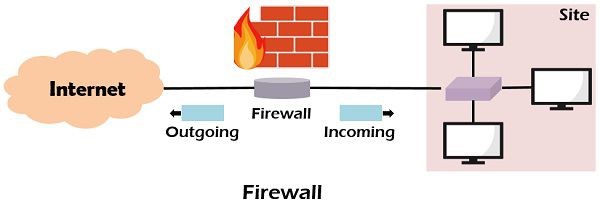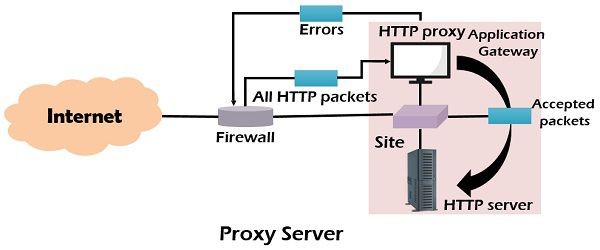1. Firewall là gì?
Tường lửa (Firewall) là 1 trong những hệ thống an ninh mạng, hoàn toàn có thể dựa trên phần cứng hoặc phần mềm, sử dụng những quy tắc để kiểm soát và điều hành traffic vào, thoát khỏi hệ thống. Tường lửa chuyển động như một rào chắn thân mạng an toàn và mạng không an toàn. Nó kiểm soát các truy vấn đến nguồn lực có sẵn của mạng thông sang 1 mô hình kiểm soát điều hành chủ động. Nghĩa là, chỉ các traffic cân xứng với chế độ được có mang trong tường lửa mới được truy vấn vào mạng, phần lớn traffic khác các bị từ bỏ chối.
Bạn đang xem: Proxy và tường lửa
Công câu hỏi của một firewall khá nặng nề khăn, bởi có tương đối nhiều dữ liệu vừa lòng pháp cần phải cấp phép tạo ra hoặc vào laptop kết nối mạng. Ví dụ, khi bọn họ truy cập vào trang web maychumienphi.com, thông báo tức, tips technology mới thì thông tin và tài liệu của trang web rất cần phải truyền từ cùng tới máy trải qua mạng để hoàn thành quá trình này.
Một firewall nên biết được sự khác hoàn toàn giữa lưu lại lượng vừa lòng pháp như trên với gần như loại tài liệu gây sợ khác.
Firewall sử dụng rule hoặc ngoại lệ để làm việc với mọi kết nối xuất sắc và loại bỏ những kết nối xấu. Chú ý chung, quá trình này được triển khai ẩn, người dùng không tìm ra hoặc không cần ảnh hưởng gì cả.
Firewall là một hệ thống nằm giữa hai mạng, chỗ nó thực hiện chính sách kiểm soát truy cập giữa những mạng đó. Firewall vận động trên lớp mạng của quy mô OSI và áp dụng mã hóa nhằm mã hóa dữ liệu trước khi truyền.

2. Proxy server là gì?
Proxy vps (Máy chủ proxy) vận động như một cổng nối giữa người dùng và Internet. Đây là một trong những server trung gian giữa người dùng cuối và trang web họ truy cập. Những máy nhà proxy cung ứng các chức năng, bảo mật và riêng tư khác nhau phụ thuộc vào nhu cầu của chúng ta hoặc chế độ công ty.
Nếu sẽ sử dụng sever proxy, lưu lượt truy vấn Internet vẫn truyền qua sever proxy theo con đường của nó đến showroom bạn yêu thương cầu. Sau đó, yêu cầu này sẽ quay trở lại cùng một sever proxy (cũng xẩy ra trường hòa hợp ngoại lệ so với quy tắc này) và máy chủ proxy đó sẽ chuyển tiếp tài liệu nhận được tự website đến bạn dùng.
Các máy chủ proxy tân tiến thực hiện nhiều các bước hơn ngoài việc chuyển tiếp các yêu mong web, nó còn triển khai bảo mật tài liệu và tăng hiệu suất mạng. Những máy chủ proxy vận động như tường lửa và bộ lọc web, cung cấp kết nối mạng share và dữ liệu bộ lưu trữ cache nhằm tăng tốc các yêu cầu thông thường. Một sever proxy xuất sắc sẽ đảm bảo người cần sử dụng và mạng nội bộ khỏi các thứ không hề mong muốn từ Internet. Cuối cùng, máy chủ proxy rất có thể cung cấp mức độ riêng tư cao.

3. Sự khác biệt giữa tường lửa cùng proxy server
| STT | FIREWALL | PROXY SERVER |
| 1 | Tường lửa rất có thể theo dõi với lọc toàn bộ các lưu lượng cho và đi trên một mạng tổng thể nhất định. | Proxy server kết nối client bên phía ngoài với server để chúng giao tiếp với nhau. |
| 2 | Tường lửa chặn các kết nối từ mạng trái phép. | Proxy server tạo ra điều kiện cho các kết nối qua mạng. |
| 3 | Tường lửa lọc dữ liệu bằng cách giám sát các gói IP được truyền qua. | Proxy vps lọc các yêu ước phía client, được tiến hành để liên kết với mạng. |
| 4 | Tường lửa liên quan đến mạng và tài liệu lớp truyền tải. | Proxy server chuyển động trên tài liệu lớp ứng dụng. |
| 5 | Tường lửa trường tồn như một interface thân mạng chỗ đông người và mạng riêng. | Proxy server hoàn toàn có thể tồn tại với những mạng nơi công cộng ở cả hai phía. |
| 6 | Tường lửa được sử dụng để bảo đảm mạng nội bộ chống lại những cuộc tấn công. | Proxy hệ thống được áp dụng để ẩn danh và quăng quật qua những hạn chế. |
| 7 | Chi chi phí được tạo ra trong tường lửa nhiều hơn thế so với proxy server. Xem thêm: Hướng Dẫn Kiểm Tra Proxy Và Tường Lửa Chính Xác Nhất, Bật Hoặc Tắt Tường Lửa Của Bộ Bảo Vệ Microsoft | Chi phí tổn được tạo thành trong proxy server ít hơn so với tường lửa. |
| 8 | Tường lửa hoạt động ở cấp độ gói. | Proxy server hoạt động ở cấp độ giao thức ứng dụng. |
4. Tóm lại sự khác nhau giữa Firewall và Proxy hệ thống là :
Firewall chặn các kết nối còn Proxy Server tạo nên điều kiện cho các kết nối. Proxy Server có thể vận động như một Firewall. Firewall hay tồn trên như một đồ họa giữa Public (mạng công cộng) cùng Private network (mạng riêng tư), trong những khi đó các Proxy hệ thống cũng rất có thể tồn trên với Public Network (mạng công cộng) trên cả 2 bên. Firewall được áp dụng để bảo đảm an toàn một mạng nội bộ (internal network) kháng lại những cuộc tấn công trong lúc ấy một Proxy vps được áp dụng để giấu tên và vứt qua các hạn chế.What is a proxy server?
What is a firewall? How does a proxy hệ thống work?
How does a firewall work?
What is the difference between proxy và firewall?
What are the main benefits of proxy servers?
What are the main benefits of firewalls?
Further reading
With around $9M, the United States has the highest average total cost of a data breach Cost of a data breach, IBM. (2022)" href="https://baochuyen.com/firewall-vs-proxy/#easy-footnote-bottom-1-54465">1. Cybersecurity is a critical issue for both businesses and individuals. Both proxy servers và firewalls provide data và network security. However, proxy server & firewall have its own benefits, & achieving cybersecurity without understanding these distinctions can be difficult.
In this article, we discussed how firewalls and proxy servers work, what benefits they provide, and how they differ from one another.
What is a proxy server?
A proxy hệ thống is an intermediary between the client machine & the target website. The proxy server receives client connection requests & transmits all incoming và outgoing data traffic between clients & web servers.
What is a firewall?
A firewall is a network security system that detects and monitors unauthorized access to lớn a private network to lớn protect it from untrustworthy public networks. There are mainly two types of firewalls, network-based and host-based systems. Both control network traffic và provide network security, but in different ways (see Figure 1).
Network-based firewalls: A network-based firewall is placed between clients & web servers. Unlike host-based firewalls, a network-based firewall provides network-level protection. A network-based computer protects the entire network. It is suited for larger networks like large-size companies.Host-based firewalls: A host-based firewall is a software that monitors network traffic between clients & servers. It is installed on a single computer and protects that computer only. It is suited for small networks like individual computers.Figure 1: Process comparison of a network-based firewall và a host-based firewall

How does a proxy server work?
Both a firewall và a proxy hệ thống are network security systems that aim khổng lồ protect user information. However, they differ in the methods và techniques they employ. We described the general proxy vps process in 6 steps:
A client requests to view nội dung on a website.The proxy vps receives the client’s connection request and hides the client’sreal IP address by assigning a different IP address.The proxy server forwards the client’s request to the destination without revealing the client’s real network id.The web hệ thống receives the client’s request.When the target web vps accepts the request, the requested information returns to lớn the proxy server.The proxy vps receives information on behalf of the user and forwards it to lớn the client.Figure 2: Process representation of proxy servers

To learn more about the various types of proxies and their features, see the ultimate guide to lớn proxy hệ thống types.
Top proxy service providers
| Smartproxy | Residential ISPMobile Datacenter | $7 | 14-day money-back | Residential Mobile |
| Bright Data | Residential ISPMobile Datacenter | $6.3 | 7-day | For all proxy types |
| Oxylabs | Residential ISPMobile Datacenter | $9 | 7-day | Residential Mobile |
| Nimble | Residential | $8 | 7-day | ❌ |
| Net Nut | Residential ISPMobile Datacenter | $15 | 7-day | ❌ |
| IPRoyal | Residential ISPMobile Datacenter | $7 | 24-hr refund | N/A |
| SOAX | Residential ISPMobile Datacenter | $6.6 | 3-day trial for $1.99 | ❌ |
Starting price/GB: The basic monthly subscription package available from the provider for residential proxy services.
How does a firewall work?
A firewall acts as a gatekeeper between clients & the public mạng internet to control all incoming và outgoing network traffic. To lớn protect clients’ private networks from public network attacks, it checks the source of the public network and filters out unwanted traffic within the network. Here is a basic roadmap of how firewalls control traffic between private & public networks (see Figure 3):
The client requests a connection khổng lồ a web server.The web vps receives the connection request và provides the requested information.The firewall controls & analyzes incoming network traffic from the web server to determine whether it should be allowed or denied. If traffic comes from a trusted web server, the firewall allows access to the web vps so the client can receive the requested information.Figure 3: Process representation of firewalls

What is the difference between proxy and firewall?
Figure 4: A comparison of proxy server and firewalls

Explained features
Technique*:Firewalls: Data that passes through a network is split up into small packets. IP packet filtering is a method used by firewalls. It is used lớn ensure that data packets arrive at the intended destination. Firewalls filter IP packets based on the rules that are configured in them. They monitor IP packets khổng lồ determine where the data packet is coming from và where it is going.Proxy servers: When the target website accepts a client’s connection request, proxy servers receive the information from the target website và forward it to lớn the client’s actual IP address without revealing the client’s real network id.Network layer** & OSI model***An OSI model consists of seven layers that allow the machine to lớn communicate with each other. It explains how data is transformed between networks. Firewalls function at layers 3 (network layer) & 4 (transport layer), whereas proxy servers function at layer 7. (application layer).
Transport layers receive incoming & outgoing data in the network traffic and divide it into data units (also called segments). They are also responsible for the amount of data transferred through the network. Transport layers determine the amount of data passed through the layer by decreasing & increasing the amount of transferred data.Network layers receive data segments from transfer layers. Received data segments are divided into packets by network layers. Network layers assign IP addresses to computers in the network to lớn ensure that data packets reach their intended destination. The second function of network layers is routing data packets from source khổng lồ destination.Application layers enable users lớn access network services by determining the identity and availability of network communication partners.Anonymity***Proxy servers mask clients’ real network IDs khổng lồ protect their identity when they connect lớn the internet.
SponsoredIt is crucial khổng lồ choose a reliable proxy provider lớn ensure your data và privacy are protected. Oxylabs provides a variety of ethically sourced proxy pools, such as residential, datacenter, mobile, và SOCKS5 proxies, based on the user’s specific data collection requirements & budget.

What are the main benefits of proxy servers?
Hide IP addressesIncrease privacy
Bypass geo-restricted content
Speed up the process of information retrieval
What are the main benefits of firewalls?
Network traffic protectionA firewall keeps a private network by filtering incoming traffic based on a set of rules. It examines the IP address & network source và rejects incoming traffic from suspicious IP addresses. You can, for example, configure your access các mục by modifying your protocol settings. Instead of using the “ANY” option, select TCP, UDP, & IP protocols. Any incoming data from TCP, UDP, & IP can pass through the firewall. Other incoming traffic will be denied by the firewall based on your predefined rules.
Protect against cyberattacksFirewalls act as a security barrier between the client và unauthorized networks. It controls IP addresses, domain names, and destination ports to lớn filter network traffic. All incoming và outgoing data must first pass through the firewall.









